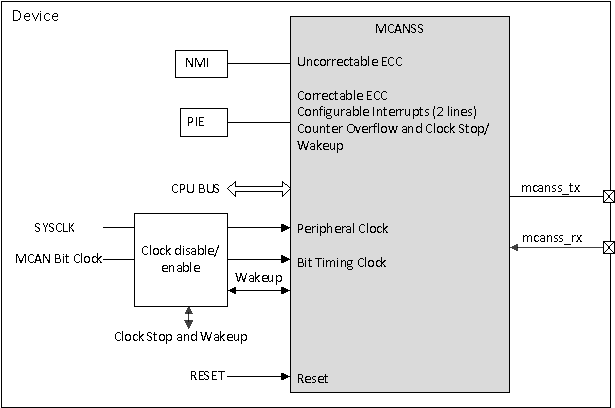SPRSP85A April 2024 – September 2024 TMS320F28P550SJ , TMS320F28P559SJ-Q1
PRODMIX
- 1
- 1 Features
- 2 Applications
- 3 Description
- 4 Device Comparison
- 5 Pin Configuration and Functions
-
6 Specifications
- 6.1 Absolute Maximum Ratings
- 6.2 ESD Ratings – Commercial
- 6.3 ESD Ratings – Automotive
- 6.4 Recommended Operating Conditions
- 6.5 Power Consumption Summary
- 6.6 Electrical Characteristics
- 6.7 Special Considerations for 5V Fail-Safe Pins
- 6.8 Thermal Resistance Characteristics for PDT Package
- 6.9 Thermal Resistance Characteristics for PZ Package
- 6.10 Thermal Resistance Characteristics for PNA Package
- 6.11 Thermal Resistance Characteristics for PM Package
- 6.12 Thermal Resistance Characteristics for RSH Package
- 6.13 Thermal Design Considerations
- 6.14
System
- 6.14.1
Power Management Module (PMM)
- 6.14.1.1 Introduction
- 6.14.1.2 Overview
- 6.14.1.3 External Components
- 6.14.1.4 Power Sequencing
- 6.14.1.5 Power Management Module Electrical Data and Timing
- 6.14.2 Reset Timing
- 6.14.3
Clock Specifications
- 6.14.3.1 Clock Sources
- 6.14.3.2
Clock Frequencies, Requirements, and Characteristics
- 6.14.3.2.1
Input Clock Frequency and Timing
Requirements, PLL Lock Times
- 6.14.3.2.1.1 Input Clock Frequency
- 6.14.3.2.1.2 XTAL Oscillator Characteristics
- 6.14.3.2.1.3 X1 Input Level Characteristics When Using an External Clock Source - Not a Crystal
- 6.14.3.2.1.4 X1 Timing Requirements
- 6.14.3.2.1.5 AUXCLKIN Timing Requirements
- 6.14.3.2.1.6 APLL Characteristics
- 6.14.3.2.1.7 XCLKOUT Switching Characteristics - PLL Bypassed or Enabled
- 6.14.3.2.1.8 Internal Clock Frequencies
- 6.14.3.2.1
Input Clock Frequency and Timing
Requirements, PLL Lock Times
- 6.14.3.3 Input Clocks and PLLs
- 6.14.3.4 XTAL Oscillator
- 6.14.3.5 Internal Oscillators
- 6.14.4 Flash Parameters
- 6.14.5 RAM Specifications
- 6.14.6 ROM Specifications
- 6.14.7 Emulation/JTAG
- 6.14.8 GPIO Electrical Data and Timing
- 6.14.9 Interrupts
- 6.14.10
Low-Power Modes
- 6.14.10.1 Clock-Gating Low-Power Modes
- 6.14.10.2
Low-Power Mode Wake-up Timing
- 6.14.10.2.1 IDLE Mode Timing Requirements
- 6.14.10.2.2 IDLE Mode Switching Characteristics
- 6.14.10.2.3 IDLE Entry and Exit Timing Diagram
- 6.14.10.2.4 STANDBY Mode Timing Requirements
- 6.14.10.2.5 STANDBY Mode Switching Characteristics
- 6.14.10.2.6 STANDBY Entry and Exit Timing Diagram
- 6.14.10.2.7 HALT Mode Timing Requirements
- 6.14.10.2.8 HALT Mode Switching Characteristics
- 6.14.10.2.9 HALT Entry and Exit Timing Diagram
- 6.14.1
Power Management Module (PMM)
- 6.15
Analog Peripherals
- 6.15.1 Block Diagram
- 6.15.2 Analog Pins and Internal Connections
- 6.15.3 Analog Signal Descriptions
- 6.15.4 Analog-to-Digital Converter (ADC)
- 6.15.5 Temperature Sensor
- 6.15.6
Comparator Subsystem (CMPSS)
- 6.15.6.1 CMPx_DACL
- 6.15.6.2 CMPSS Connectivity Diagram
- 6.15.6.3 Block Diagram
- 6.15.6.4
CMPSS Electrical Data and Timing
- 6.15.6.4.1 CMPSS Comparator Electrical Characteristics
- CMPSS Comparator Input Referred Offset and Hysteresis
- 6.15.6.4.2 CMPSS DAC Static Electrical Characteristics
- 6.15.6.4.3 CMPSS Illustrative Graphs
- 6.15.6.4.4 Buffered Output from CMPx_DACL Operating Conditions
- 6.15.6.4.5 Buffered Output from CMPx_DACL Electrical Characteristics
- 6.15.7 Buffered Digital-to-Analog Converter (DAC)
- 6.15.8 Programmable Gain Amplifier (PGA)
- 6.16 Control Peripherals
- 6.17
Communications Peripherals
- 6.17.1 Modular Controller Area Network (MCAN)
- 6.17.2 Inter-Integrated Circuit (I2C)
- 6.17.3 Power Management Bus (PMBus) Interface
- 6.17.4 Serial Communications Interface (SCI)
- 6.17.5 Serial Peripheral Interface (SPI)
- 6.17.6 Local Interconnect Network (LIN)
- 6.17.7 Fast Serial Interface (FSI)
- 6.17.8 Universal Serial Bus (USB)
-
7 Detailed Description
- 7.1 Overview
- 7.2 Functional Block Diagram
- 7.3 Memory
- 7.4 Identification
- 7.5 Bus Architecture – Peripheral Connectivity
- 7.6 C28x Processor
- 7.7 Control Law Accelerator (CLA)
- 7.8 Embedded Real-Time Analysis and Diagnostic (ERAD)
- 7.9 Direct Memory Access (DMA)
- 7.10 Device Boot Modes
- 7.11 Security
- 7.12 Watchdog
- 7.13 C28x Timers
- 7.14 Dual-Clock Comparator (DCC)
- 7.15 Configurable Logic Block (CLB)
- 8 Reference Design
- 9 Device and Documentation Support
- 10Revision History
- 11Mechanical, Packaging, and Orderable Information
6.17.1 Modular Controller Area Network (MCAN)
The Controller Area Network (CAN) is a serial communications protocol that efficiently supports distributed real-time control with a high level of reliability. CAN has high immunity to electrical interference and the ability to detect various type of errors. In CAN, many short messages are broadcast to the entire network, which provides data consistency in every node of the system.
The MCAN module supports both classic CAN and CAN FD (CAN with flexible data-rate) protocols. The CAN FD feature allows higher throughput and increased payload per data frame. Classic CAN and CAN FD devices may coexist on the same network without any conflict provided that partial network transceivers, which can detect and ignore CAN FD without generating bus errors, are used by the classic CAN devices. The MCAN module is compliant to ISO 11898-1:2015.
The availability of the CAN FD feature is dependent on the device's part number. Refer to the device data sheet for more information.
 Figure 6-64 MCAN Module Overview
Figure 6-64 MCAN Module OverviewThe MCAN module implements the following features:
- Conforms with CAN Protocol 2.0 A, B and ISO 11898-1:2015
- Full CAN FD support (up to 64 data bytes)
- AUTOSAR and SAE J1939 support
- Flexible Message RAM allocation
(maximum configuration below is for a device with 4352 32-bit word message
RAM)
- Up to 32 dedicated transmit buffers
- Configurable transmit FIFO, up to 32 elements
- Configurable transmit queue, up to 32 elements
- Configurable transmit Event FIFO, up to 32 elements
- Up to 64 dedicated receive buffers
- Two configurable receive FIFOs, up to 64 elements each
- Up to 128 filter elements
- Loop-back mode for self-test
- Maskable interrupt (two configurable interrupt lines, correctable ECC, counter overflow and clock stop/wakeup)
- Non-maskable interrupt (uncorrectable ECC)
- Two clock domains (CAN clock/host clock)
- ECC check for Message RAM
- Clock stop and wake-up support
- Timestamp counter
Non-supported features:
- Host bus firewall
- Clock calibration
- Debug over CAN